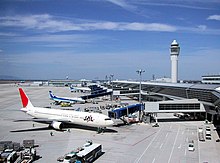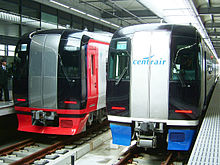Nagoya: diferència entre les revisions
| Línia 61: | Línia 61: | ||
* [[Sakuma Morimasa]]: samurai japonès del període Sengoku<ref name="Turnbull 2008 p. 65">{{cite book | last=Turnbull | first=S. | title=The Samurai Swordsman: Master of War | publisher=Frontline Books | year=2008 | isbn=978-1-84415-712-9 | url=https://books.google.es/books?id=WPt7BAAAQBAJ&pg=PA65 | access-date=2021-08-18 | page=65}}</ref> |
* [[Sakuma Morimasa]]: samurai japonès del període Sengoku<ref name="Turnbull 2008 p. 65">{{cite book | last=Turnbull | first=S. | title=The Samurai Swordsman: Master of War | publisher=Frontline Books | year=2008 | isbn=978-1-84415-712-9 | url=https://books.google.es/books?id=WPt7BAAAQBAJ&pg=PA65 | access-date=2021-08-18 | page=65}}</ref> |
||
* [[Maeda Toshimasu]]: samurai japonès del període Sengoku<ref name="Pettersson 2017 p. 101">{{cite book | last=Pettersson | first=J. | title=The Yonezawa Matchlock. Mighty Gun of the Uesugi Samurai | publisher=Lulu.com | year=2017 | isbn=978-1-387-06449-6 | url=https://books.google.es/books?id=txNHDwAAQBAJ&pg=PA101 | access-date=2021-08-18 | page=101}}</ref> |
* [[Maeda Toshimasu]]: samurai japonès del període Sengoku<ref name="Pettersson 2017 p. 101">{{cite book | last=Pettersson | first=J. | title=The Yonezawa Matchlock. Mighty Gun of the Uesugi Samurai | publisher=Lulu.com | year=2017 | isbn=978-1-387-06449-6 | url=https://books.google.es/books?id=txNHDwAAQBAJ&pg=PA101 | access-date=2021-08-18 | page=101}}</ref> |
||
* [[Sakichi Toyoda]]: inventor<ref name="Toyota Jidōsha Kabushiki Kaisha トヨタ自動車株式会社 Toyota Jidōsha Kōgyō Kabushiki Kaisha 1988 p. ">{{cite book | author=Toyota Jidōsha Kabushiki Kaisha | author2=トヨタ自動車株式会社 | author3=Toyota Jidōsha Kōgyō Kabushiki Kaisha | title=Toyota: A History of the First 50 Years | publisher=Toyota Motor Corporation | year=1988 | url=https://books.google.es/books?id=e6UeAQAAMAAJ | access-date=2021-08-18 | page=}}</ref> |
* [[Sakichi Toyoda]]: inventor<ref name="Wada 2020 p. 45">{{cite book | last=Wada | first=K. | title=The Evolution of the Toyota Production System | publisher=Springer Singapore | series=Studies in Economic History | year=2020 | isbn=978-981-15-4928-1 | url=https://books.google.es/books?id=Z5nqDwAAQBAJ&pg=PA45 | access-date=2021-08-18 | page=45}}</ref><ref name="Toyota Jidōsha Kabushiki Kaisha トヨタ自動車株式会社 Toyota Jidōsha Kōgyō Kabushiki Kaisha 1988 p. ">{{cite book | author=Toyota Jidōsha Kabushiki Kaisha | author2=トヨタ自動車株式会社 | author3=Toyota Jidōsha Kōgyō Kabushiki Kaisha | title=Toyota: A History of the First 50 Years | publisher=Toyota Motor Corporation | year=1988 | url=https://books.google.es/books?id=e6UeAQAAMAAJ | access-date=2021-08-18 | page=}}</ref> |
||
* [[Kiichiro Toyoda]]: fill de Sakichi Toyoda, creador de [[Toyota Motor Corporation]] |
* [[Kiichiro Toyoda]]: fill de Sakichi Toyoda, creador de [[Toyota Motor Corporation]] |
||
* [[Akio Morita]]: cofundador de [[Sony]] |
* [[Akio Morita]]: cofundador de [[Sony]] |
||
Revisió del 03:28, 18 ago 2021
| 名古屋市 (ja) | |||||
| Himne | Nagoya City Anthem (en) | ||||
|---|---|---|---|---|---|
| Símbol oficial | Camforer (arbre) Lilium (flor) | ||||
| Localització | |||||
| |||||
| Estat | Japó | ||||
|
| |||||
| Prefectura | prefectura d'Aichi | ||||
| Capital de | |||||
| Capital | Naka-ku (en) | ||||
| Conté la subdivisió | Atsuta-ku Chikusa-ku (en) Higashi-ku (en) Kita-ku (en) Meito-ku (en) Midori-ku (en) Minami-ku (en) Minato-ku (en) Mizuho-ku (en) Moriyama-ku (en) Naka-ku (en) Nakagawa-ku (en) Nakamura-ku Nishi-ku (en) Showa-ku (en) Tenpaku-ku (en) | ||||
| Població humana | |||||
| Població | 2.326.844 (2021) | ||||
| Malnom | 中京 | ||||
| Llengua utilitzada | Nagoya dialect (en) | ||||
| Geografia | |||||
| Part de | |||||
| Superfície | 326,43 km² | ||||
| Banyat per | badia d'Ise, Port of Nagoya (en) | ||||
| Punt més alt | Mount Tōgoku (en) | ||||
| Limita amb | Nisshin Nagakute Ama (Aichi) Kitanagoya Tōgō Oharu (en) Toyoyama City (en) Kanie (en) Kiyosu Owariasahi Seto Toyoake Kasugai Ōbu Tokai (en) Tobishima (en) | ||||
| Dades històriques | |||||
| Anterior | Atsuta (en) | ||||
| Creació | 1r octubre 1889 | ||||
Esdeveniment clau
| |||||
| Organització política | |||||
| Òrgan executiu | Ajuntament de Nagoya | ||||
| • Alcalde | Takashi Kawamura (2009–) | ||||
| Òrgan legislatiu | ple de l'Ajuntament de Nagoya , (Escó: 75) | ||||
| Membre de | |||||
| Identificador descriptiu | |||||
| Codi postal | 460-8508 | ||||
| Fus horari | |||||
| Domini de primer nivell | .nagoya (oc) | ||||
| Prefix telefònic | 52 | ||||
| Flor | Lilium | ||||
| Arbre | Cinnamomum camphora | ||||
| Altres | |||||
| Agermanament amb | Poona Los Angeles (1959–) Ciutat de Mèxic (1978–) Nanquín (1978–) Sydney (1980–) Toyota (1986–) Torí (2005–) Callao (2009–) Rikuzentakata (2014–) Reims (2017–) Taichung (2018–) Taixkent (2019–) | ||||
| Lloc web | city.nagoya.jp | ||||
Nagoya (
Història
La ciutat va ser fundada l'1 d'octubre del 1889[2] essent totalment destruïda durant els bombardejos de 1945 i reconstruïda després de nou.[3]
Transport


Nagoya és servida per l'aeroport internacional Chubu Centrair (ONG), construït en una illa artificial a Tokoname.[4] L'aeroport té vols internacionals i un gran volum de vols nacionals.
Un segon aeroport és l'aeròdrom de Nagoya (aeroport de Komaki, NKM) a prop del límit de la ciutat amb Komaki i Kasugai.[5] El 17 de febrer de 2005, els vols comercials internacionals de l'aeroport de Nagoya es van traslladar a l'aeroport de Centrair. L’aeròdrom de Nagoya s’utilitza ara per a l'Aviació general i com a base aèria i és el centre principal de Fuji Dream Airlines.[6]
L'estació de Nagoya, l'estació de tren més gran del món per superfície,[7] es troba a la línia Tōkaidō Shinkansen, la línia principal de Tōkaidō i la línia principal de Chūō, entre d'altres. JR Central, que opera el Tōkaidō Shinkansen, té la seu allà. Meitetsu també té seu a Nagoya i, juntament amb Kintetsu, proporciona servei ferroviari regional a les regions de Tōkai i Kansai. El metro de Nagoya proporciona servei de trànsit urbà.[8]
El port de Nagoya és el port més gran pel seu valor comercial internacional al Japó.[9][10] Toyota Motor Corporation exporta per aquest port.
Nagoya és coneguda pel seu pla ordenat de carrers, del qual és responsable el shōgun Tokugawa Ieyasu. [11]
Districtes
Nagoya té 16 ku (districtes):

Personatges cèlebres
- Minamoto no Yoritomo: fundador del shogunat Kamakura
- Tokugawa Ieyasu: fundador i primer shogun del Shogunat Tokugawa
- Oda Nobunaga: samurai japonès del període Sengoku
- Toyotomi Hideyoshi: samurai japonès del període Sengoku
- Shibata Katsuie: samurai japonès del període Sengoku
- Niwa Nagahide: samurai japonès del període Sengoku[13]
- Maeda Toshiie: samurai japonès del període Sengoku
- Katō Kiyomasa: samurai japonès del període Sengoku
- Sassa Narimasa: samurai japonès del període Sengoku
- Sakuma Nobumori: samurai japonès del període Sengoku
- Sakuma Morimasa: samurai japonès del període Sengoku[14]
- Maeda Toshimasu: samurai japonès del període Sengoku[15]
- Sakichi Toyoda: inventor[16][17]
- Kiichiro Toyoda: fill de Sakichi Toyoda, creador de Toyota Motor Corporation
- Akio Morita: cofundador de Sony
- Koji Kondo: compositor de videojocs i director de so
- Shinichi Suzuki: violinista
- Akira Toriyama: autor de Bola de Drac
- Naoko Mori: actriu
- Shigefumi Mori: matemàtic, medalla Fields
- Makoto Kobayashi: Premi Nobel de Física
- Susumu Tonegawa (1939 - ) metge i biòleg, Premi Nobel de Medicina o Fisiologia de l'any 1987.
- Toshihide Masukawa: Premi Nobel de Física[18]
- Midori Ito: campió del món de patinatge artístic
- Miki Ando: campió del món de patinatge artístic
- Mao Asada: campiona del món de patinatge artístic
- Shomei Tomatsu: fotògraf
Agermanaments
La ciutat compta amb cinc agermanaments:[19]
- Los Angeles, Estats Units d'Amèrica
- Ciutat de Mèxic, Mèxic
- Sydney, Austràlia
- Torí, Itàlia
- Reims, França
Referències
- ↑ Leszczynski, J.; Shukla, M. Practical Aspects of Computational Chemistry II: An Overview of the Last Two Decades and Current Trends. Springer Netherlands, 2012, p. 11 (SpringerLink : Bücher). ISBN 978-94-007-0923-2.
- ↑ Reed, E.J.. Japan: Its History, Traditions, and Religions: With the Narrative of a Visit in 1879. Cambridge University Press, 2012, p. 205 (Cambridge Library Collection - East and South-East Asian History). ISBN 978-1-108-04568-1.
- ↑ United States Strategic Bombing Survey. The Effects of Air Attack on the City of Nagoya. United States Strategic Bombing Survey, Urban Areas Division, 1947 (Reports: Pacific war). ISBN 978-0-598-65247-8.
- ↑ Macioszek, E.; Sierpiński, G. Modern Traffic Engineering in the System Approach to the Development of Traffic Networks: 16th Scientific and Technical Conference "Transport Systems. Theory and Practice 2019" Selected Papers. Springer International Publishing, 2019, p. 217 (Advances in Intelligent Systems and Computing). ISBN 978-3-030-34069-8.
- ↑ Genzberger, C.; Hinkelman, E.G.. Japan Business: The Portable Encyclopedia for Doing Business with Japan. World Trade Press, 1994, p. 139 (Country Business Guide Series). ISBN 978-0-9631864-2-3.
- ↑ Lee, J.W.. Aviation Law and Policy in Asia: Smart Regulation in Liberalized Markets. Brill, 2020, p. 22 (Brill's Asian Law Series). ISBN 978-90-04-43958-0.
- ↑ Pratelli, A.; Brebbia, C.A.. Urban Transport XVI: Urban Transport and the Environment in the 21st Century. WIT Press, 2010, p. 256 (WIT transactions on ecology and the environment). ISBN 978-1-84564-456-7.
- ↑ Gunn, S.; Townsend, S.C.. Automobility and the City in Twentieth-Century Britain and Japan. Bloomsbury Publishing, 2019, p. 63 (SOAS Studies in Modern and Contemporary Japan). ISBN 978-1-350-07594-8.
- ↑ Nagoya Port Authority. Port of Nagoya, 2010.
- ↑ Ogo, A. Port of Nagoya Development and the Role of Government. Survey and Design Office, Regional Office no. 4, Ministry of Transport, Government of Japan.
- ↑ «'The linear roads of Nagoya' at 名古屋.tokyo».}
- ↑ Mitchelhill, J.; Green, D. Castles of the Samurai: Power and Beauty. Kodansha Europe, 2003. ISBN 978-4-7700-2954-6.
- ↑ Fr?d?ric, L.; Roth, K. Japan Encyclopedia. Belknap Press of Harvard University Press, 2002, p. 722 (Harvard University Press reference library). ISBN 978-0-674-01753-5.
- ↑ Turnbull, S. The Samurai Swordsman: Master of War. Frontline Books, 2008, p. 65. ISBN 978-1-84415-712-9.
- ↑ Pettersson, J. The Yonezawa Matchlock. Mighty Gun of the Uesugi Samurai. Lulu.com, 2017, p. 101. ISBN 978-1-387-06449-6.
- ↑ Wada, K. The Evolution of the Toyota Production System. Springer Singapore, 2020, p. 45 (Studies in Economic History). ISBN 978-981-15-4928-1.
- ↑ Toyota Jidōsha Kabushiki Kaisha. Toyota: A History of the First 50 Years. Toyota Motor Corporation, 1988.
- ↑ Gupta, S. DICTIONARY OF PHYSICS: For students of Class VI to X. Notion Press, 2018, p. 571. ISBN 978-1-64324-694-9.
- ↑ Agermanaments[Enllaç no actiu] (anglès)
Enllaços externs
- Lloc web oficial (japonès)
- Lloc web oficial (anglès)











